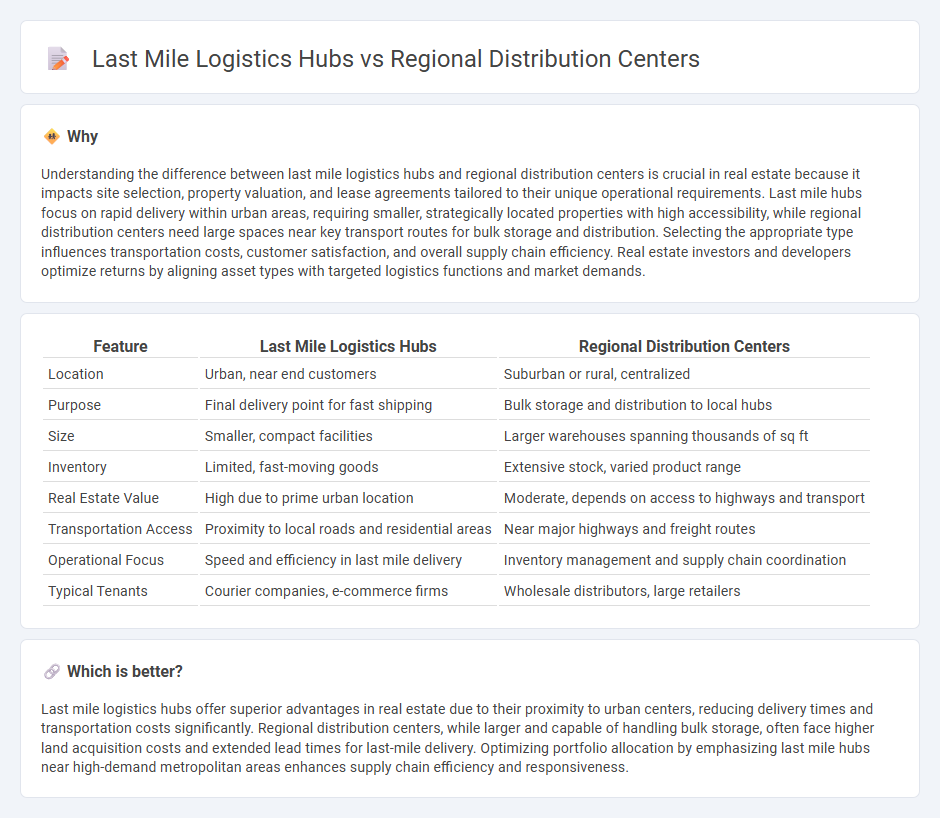
Last mile logistics hubs focus on rapid, localized delivery within urban areas, optimizing convenience and speed for e-commerce fulfillment. Regional distribution centers serve broader geographic zones, handling large inventory volumes that support multiple last mile hubs and retail outlets. Discover how these real estate solutions shape supply chain efficiency and urban planning strategies.
Why it is important
Understanding the difference between last mile logistics hubs and regional distribution centers is crucial in real estate because it impacts site selection, property valuation, and lease agreements tailored to their unique operational requirements. Last mile hubs focus on rapid delivery within urban areas, requiring smaller, strategically located properties with high accessibility, while regional distribution centers need large spaces near key transport routes for bulk storage and distribution. Selecting the appropriate type influences transportation costs, customer satisfaction, and overall supply chain efficiency. Real estate investors and developers optimize returns by aligning asset types with targeted logistics functions and market demands.
Comparison Table
| Feature | Last Mile Logistics Hubs | Regional Distribution Centers |
|---|---|---|
| Location | Urban, near end customers | Suburban or rural, centralized |
| Purpose | Final delivery point for fast shipping | Bulk storage and distribution to local hubs |
| Size | Smaller, compact facilities | Larger warehouses spanning thousands of sq ft |
| Inventory | Limited, fast-moving goods | Extensive stock, varied product range |
| Real Estate Value | High due to prime urban location | Moderate, depends on access to highways and transport |
| Transportation Access | Proximity to local roads and residential areas | Near major highways and freight routes |
| Operational Focus | Speed and efficiency in last mile delivery | Inventory management and supply chain coordination |
| Typical Tenants | Courier companies, e-commerce firms | Wholesale distributors, large retailers |
Which is better?
Last mile logistics hubs offer superior advantages in real estate due to their proximity to urban centers, reducing delivery times and transportation costs significantly. Regional distribution centers, while larger and capable of handling bulk storage, often face higher land acquisition costs and extended lead times for last-mile delivery. Optimizing portfolio allocation by emphasizing last mile hubs near high-demand metropolitan areas enhances supply chain efficiency and responsiveness.
Connection
Last mile logistics hubs and regional distribution centers collaborate to streamline real estate utilization by optimizing delivery speed and reducing transportation costs. Strategic placement of regional distribution centers near key urban areas supports last mile hubs in efficiently managing inventory and fulfilling customer orders faster. This interconnected network enhances supply chain responsiveness and maximizes property value in commercial real estate markets.
Key Terms
Location Proximity
Regional distribution centers are strategically positioned near major transportation routes and urban centers to optimize bulk storage and efficient redistribution at a larger scale. Last mile logistics hubs prioritize proximity to end consumers and urban neighborhoods to enable rapid delivery and minimize transit times in final shipment stages. Explore the critical impact of location proximity on supply chain efficiency and customer satisfaction for deeper insights.
Facility Size
Regional distribution centers typically span 200,000 to 1,000,000 square feet, designed to store vast inventories and facilitate bulk shipments across extensive geographic areas. In contrast, last mile logistics hubs average between 5,000 and 50,000 square feet, optimized for rapid sorting and dispatching of smaller order volumes to end consumers. Explore facility size impacts on operational efficiency to better understand supply chain logistics.
Transportation Infrastructure
Regional distribution centers strategically located near major highways and rail networks optimize bulk transportation efficiency by consolidating inventory closer to demand clusters. Last mile logistics hubs leverage urban transportation infrastructure, such as local road networks and public transit systems, to facilitate rapid, flexible delivery within dense metropolitan areas. Explore how integrating both infrastructure models enhances supply chain resilience and customer satisfaction.
Source and External Links
Regional vs. Centralized Distribution - Evaluates the differences between regional and centralized distribution strategies, focusing on delivery speed and inventory management.
What is RDC Delivery? - Discusses the role of Regional Distribution Centres (RDCs) in enhancing product availability, reducing transportation costs, and improving supply chain flexibility.
Walmart Distribution Center Network USA - Describes Walmart's extensive network of regional general merchandise distribution centers across the United States, highlighting their strategic role in the company's distribution network.
 dowidth.com
dowidth.com